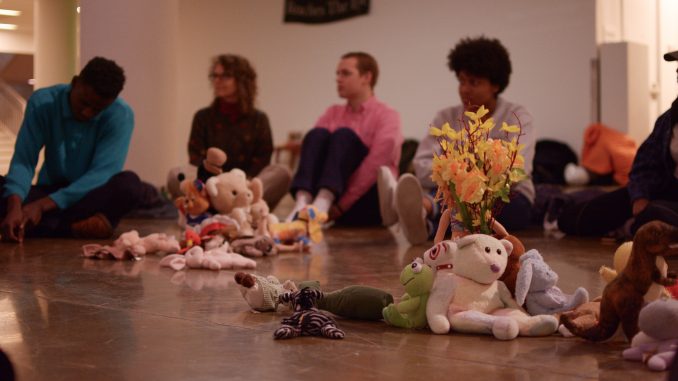
The same night Gaelen McCartney was installing his senior thesis project in the Tyler School of Art, a custodian told him he’s lost hundreds of friends to gun violence—he can’t even keep track of exactly how many.
“He immediately opened up about how these memorials are always in his community and how he’s been shot numerous times before,” McCartney said.
“For me to have that very intimate moment with him while I’m installing the piece, it really gave me gratification that I created a space where people felt comfortable enough to share their stories, their emotions and their views on Black Lives Matter,” he added.
McCartney’s senior thesis project, titled “No Visible Light Reaches the Eye,” was displayed in Tyler’s Student Lounge Gallery from Wednesday to Friday. He chose to focus on the movement because he said it is close to his heart.
“I realized that I had this platform and this space to create something to show who I am as an artist,” said the senior fibers and material studies major. “I wanted to create something that was important to me that provided a discussion for other people. Black Lives Matter is important to me because it affects a lot of people who are very close to me.”
McCartney said the diversity in his hometown of Newburgh, New York, set a precedent for his college career.
He said he “always grew up around people who were different” from him, but when he left his hometown, McCartney realized that this was not the case for everyone.
McCartney continued to surround himself with diverse groups of people during his time at Temple. His sophomore year he joined a discussion group at Temple facilitated by the Honors Program called Honorables of Color.
McCartney joined because he said he “missed the diversity” that he felt in his hometown.
His senior thesis piece was a black weaving that measures 26-and-a-half feet by 40 inches. “Black Lives Matter,” is woven into the fabric 80 times.
“I wanted it to be black on black with the text because I wanted people to know that the structure of the weave is held together by the words ‘Black Lives Matter’ and that the weaving itself would not be able to stay cohesive if the text wasn’t there to make it permanent,” McCartney said.
“You have to get close to read it, which is kind of what I wanted,” he added.
McCartney also had stuffed animals and candles placed in clusters on the gallery’s floor. These clusters were meant to create the illusion of “the piece coming off the wall and into the gallery environment to sort of resemble those roadside memorials that we see in neighborhoods after gun violence or someone passing away,” he added.
The second part of his thesis consisted of a discussion about the Black Lives Matter movement, which took place last Thursday as participants sat on the floor among the stuffed animals and candles.

“This is really important, because it continues the conversation rather than letting it be like, ‘Hey that happened, let’s move on to the next conversation,’” said Mikaela Cook, a former Japanese major at Temple.
McCartney said he considers himself an “ally” of the Black Lives Matter movement.
“I think I have become aware that I have to be very cautious the way I word things,” McCartney said. “I am constantly reminding myself and thinking about what I am advocating for are experiences that I have never had, because I am not a person of color.”
Participants of the discussion recognized the difficulty of making Black Lives Matter a cause that people of all races can support.
“You can have one-sided conversations with people all you want, but sometimes they’re just not going to process the information that you’re telling them,” said Nadira Goffe, a sophomore English major. “It’s hard in situations like this, because how do you make Black Lives Matter relatable to people who wouldn’t be considered under the umbrella?”
“I’m not afraid to talk about it because I think it’s something that we all need to be acknowledging and talking about,” McCartney said.
Erin Blewett can be reached at erin.clare.blewett@temple.edu.
Video by Linh Than.


Be the first to comment